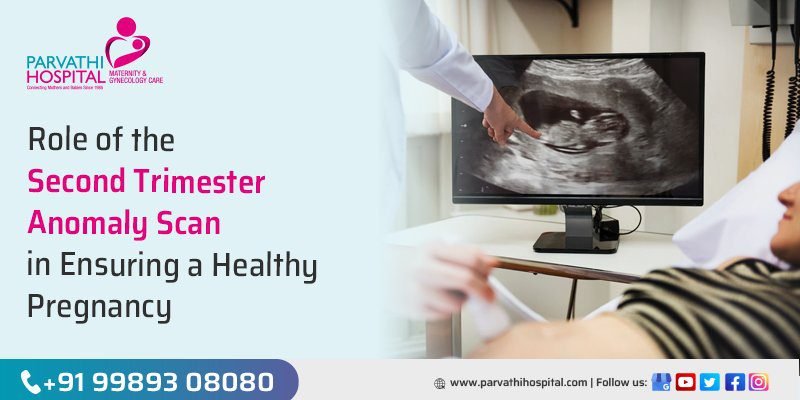Subtotal $0.00
Role of the Second Trimester Anomaly Scan in Ensuring a Healthy Pregnancy
The anatomy or anomaly scan, often known as the 20-week anomaly scan, is carried out between weeks 18 and 22 of pregnancy. It can identify congenital anomalies and monitor the growth of fetal organs and body parts. You can usually determine the fetus’s gender. Visit Parvathi hospitals to undergo a second trimester anomaly scan under one the best gynecology doctors in Hyderabad. The sonographer who conducts the ultrasound will take measurements and ensure that the fetus is growing in accordance with its age. You might also learn the gender of the fetus at this appointment.
What Is a Second-trimester Anomaly Scan?
A prenatal ultrasound carried out between 18 and 22 weeks of pregnancy is a 20-week anomaly scan, often known as an anatomy or abnormality scan. It examines the fetus’s physical growth and can spot significant anatomical defects and some congenital diseases. Your healthcare professional will use a 2D, 3D, or 4D ultrasound to obtain pictures of the fetus inside the uterus. The sonographer, who performs ultrasounds, will take measures and make sure the fetus is developing proportionately to its age. At this session, you might find out the fetus’s gender as well.
What Does the Second Trimester Anomaly Look For?
Your fetal organs and body parts are measured during a 20-week anomaly scan to ensure the fetus is typically developing. Additionally, the scan looks for indications of congenital impairments or structural problems with organs. Your doctor will specifically check the following areas in the fetus:
- Heart.
- spine, neck, and brain.
- Bladder and kidneys.
- Legs and arms.
- Foot, toes, and fingers of the hands.
- Chin, eyes, nose, lips, and face.
- Lungs and chest.
- Intestines and stomach.
Additionally, the ultrasound technologist will:
- Check the fetal heart rate for irregular beats.
- Look for blood flow and where the umbilical cord connects to the placenta.
- Make sure the placenta is not covering your cervix by looking at it (placenta previa).
- Examine your cervix, ovaries, and uterus.
- Calculate the amniotic fluid volume.
During this ultrasound, several pictures are captured. On the screen, you’ll see lines drawn by the sonographer. This line serves as a ruler to record the dimensions of the limbs and organs. These measures are contrasted with the date of your due date. You might occasionally hear that you are measuring ahead, on schedule, or behind your due date. The fetus is deemed sufficiently developing if measures are within 10 to 14 days of the expected delivery date. Unless the fetus measures outside of that range, your due date won’t alter.
Risks Associated with Second trimester Anomaly
Even though the second trimester 4d anomaly scan is an effective tool for identifying potential fetal abnormalities and ensuring a safe pregnancy, it’s essential to be aware of some dangers and restrictions connected with the operation. The importance of keeping in mind that these hazards are typically negligible and exceeded by the advantages of early discovery and adequate medical therapy. The following are a few risks to think about:
1. False-Positive Results
The anomaly scan in pregnancy occasionally picks up specific markers or subtle indicators that could allude to a possible anomaly. However, additional testing could be necessary to either confirm or disprove the existence of a fetal abnormality. False-positive findings can make pregnant parents anxious and stressed until further tests can determine the truth.
2. Limited Detection
The second-trimester anomaly scan pregnancy successfully spots many structural anomalies, although it may miss other fetal abnormalities. Some issues might not be discovered until later in pregnancy or after delivery.
3. Incomplete Information
While the anomaly scan offers helpful insights into the baby’s growth, it cannot ensure that all health problems will be resolved. Some fetal defects may only be discovered later in pregnancy or after birth; not all can be detected by ultrasound.
4. Need for Additional Tests
Occasionally, aberrant results from the anomaly scan may call for additional diagnostic procedures such as amniocentesis or genetic testing. The parents must carefully consider the hazards associated with these tests.
5. Emotional Impact
Expectant parents may experience emotional difficulty if a fetal abnormality is discovered. Stress and worry can be brought on by dealing with the unknown and possible repercussions of the scan results.
Before and following the anomaly scan, healthcare professionals must offer pregnant parents the proper guidance and assistance. Parents can manage potential difficulties and make educated decisions about their pregnancy with open communication, correct information, and access to professional advice. Despite these hazards, the second-trimester anomaly scan is still an essential part of thorough prenatal care. As a result, it helps to improve the overall health and well-being of both the unborn child and the expectant parents because of its capacity to identify numerous fetal defects early in pregnancy.
Final Words
In conclusion, the 20-week anomaly scan is crucial for ensuring a successful pregnancy since it offers essential information about the well-being of the developing fetus. Although surgery has some dangers and restrictions, the advantages considerably outweigh these.
This crucial ultrasound examination, usually done between 18 and 22 weeks of pregnancy, tries to find any fetal problems and any structural anomalies early on. Healthcare professionals can offer timely treatments, make wise judgments, and give pregnant parents the support they need, thanks to the information received from the scan.
Ultimately, the second-trimester anomaly scan is crucial to thorough prenatal care, educating parents, and enabling medical professionals to ensure the best outcomes for the baby and the family. Expectant parents can enjoy their pregnancy and look forward to bringing their child into a world of love and care by emphasizing routine ultrasound screenings and prenatal care.


Comments are closed